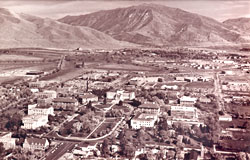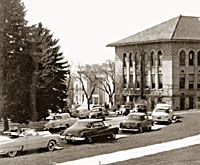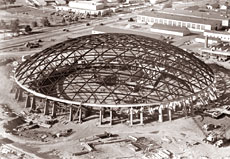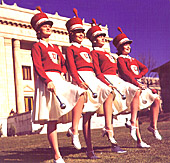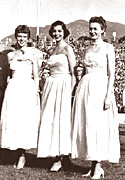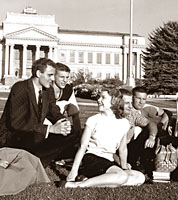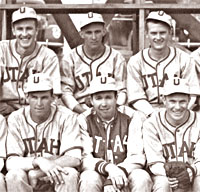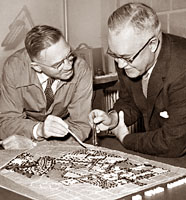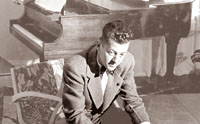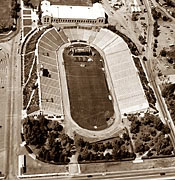801-585-3073
University of Utah Sesquicentennial, 1850 - 2000
- Bonneville Salt Flats/Utah Motorsports
- Images of Glen Canyon
- Japanese-American Photo Archives
- Quinney Outdoor Recreation Exhibits
- University of Utah History
- Utah Centennial 1896-1996 - A Photo Exhibit
- Utah Inter-Urban Railway History in Photographs
- Working Together: A Utah Portfolio
Rapid Expansion, 1946-1964

In September, 1945, students, faculty, and staff of the University of Utah celebrated along with the rest of the world when World War II ended. During the last year of the conflict, enrollment at the University had dropped to a new low of 3,418 students; but within a year of the end of the war, the student population had doubled to 6,821. This influx of students caused severe overcrowding at the University, where the building program had been slowed or suspended by the needs of national defense. Fortunately, however, during the war Fort Douglas had been expanded drastically, and now, with the war over, the temporary buildings–some of which are still in use at the turn of the new century--erected to accommodate the soldiers could now be turned to more peaceful purposes.
President Leroy Cowles resigned in 1946, and was replaced by A. Ray Olpin. President Olpin, who served from 1946 to 1964, presided over an explosive expansion of the University, both in student population, area, and buildings. He also began active recruitment of new faculty, to serve the burgeoning student body. That same year, the Naval Services building was completed, and the Graduate School was made an integral part of the University. From this point, changes in the campus and the administration of the University came so hard and fast that it must have seemed like a blur to those who remembered the old, quiet school of the pre- war days. In 1947, the University organized the School of Fine Arts and the School of Nursing. The first PhD ever awarded by the University was given to James Sugihara, in chemistry. More and more married students meant that Stadium Village, former barracks located east of Rice Stadium, was opened to house student families. The Utah Symphony moved onto campus in 1948, and began giving performances in Kingsbury Hall. At the same time, the University's dance program gained national recognition. As the military began to downsize, Fort Douglas began to shrink, and the primary benefactor was the University of Utah. Three hundred acres were deeded to the school in 1948, more than doubling the size of the campus. That same year, enrollment reached over 12,000, necessitating bringing in buildings from the Topaz Internment Camp in western Utah, and other remote locations.
The University celebrated its centennial in 1950. That year, the first class of the College of Pharmacy graduated, and the College of Business offered an MBA for the first time. The University athletic department was busy during the 1950s as well. In 1953, under coach Jack Curtice, the football team defeated BYU in their first nationally televised football game. Besides football, men could participate in basketball, baseball, skiing, track, swimming, wrestling, golf. The only organized team for women was a ski team, but they could enjoy intramural archery, volleyball, tennis, and basketball. Orson Spencer Hall, named for the first chancellor of the University of Deseret, opened in 1955, followed the next year by Ballif Hall, a men's residence. The University entered the television age in 1957, with the establishment of KUED, an educational TV station. The Baby Boom generation was reaching the point where their numbers would soon crowd the University's facilities, and President Olpin embarked on an ambitious ten-year building program in 1957 that would change the face of the campus forever. Within a decade, more than thirty buildings were completed. The first of these was the new union building, later named in honor of President Olpin. Construction began on the Merrill Engineering building in 1958, and on Milton Bennion Hall the next year. Also in 1958, the University acquired a 35-acre plot of land near the Veteran's Hospital and began construction of new married student housing.
President Olpin retired from University service in 1964, but he left a campus greatly expanded both in size and in student population. Under his leadership, the campus had quadrupled in size, and the number of buildings had also increased dramatically. Student population had gone from under 4,000 when he began his tenure, to over 12,000 by the time he left. Little could he realize, as he handed over the reins to new President James C. Fletcher, that tensions were at work in the country that would reach even to the cloistered halls of the campus on the east bench of Salt Lake City.
Presidents of the era:
A. Ray Olpin
president, 1946 - 1964
